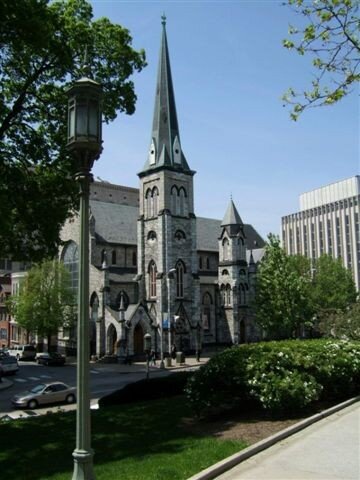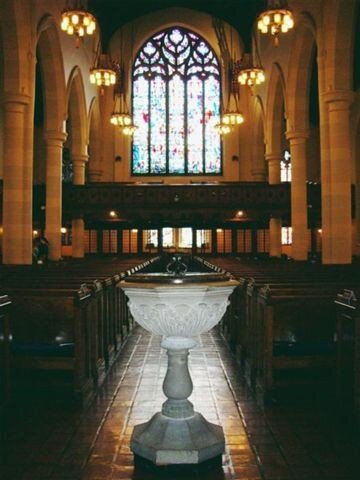Pine Street Presbyterian Church
310 North 3rd Street, Harrisburg


E.M. Skinner, Op. 506, 1926
Moller, Op. R-706, 1963
Moller, Op. R-1212, 1991
THE ORGAN at Pine Street Presbyterian Church was originally designed and installed in 1926 by the Skinner Organ Company of Boston, Massachusetts as a part of the rebuilding of the church under the direction of architect Ralph Adams Cram of Boston. It was originally scheduled for installation in an area above the choir loft, but for unknown reasons, the location was changed to two shallow chambers on either side of the loft, providing a much better location in all respects. At the time, Skinner was the premier organ builder in the United States.
This instrument served virtually unchanged until 1963 when it was rebuilt and enlarged by the M.P. Möller Company of Hagerstown, Maryland. During this rebuild the best of the Skinner pipework and virtually all of the original chestwork were saved, renewed and reinstalled in what was a mostly new instrument. Of particular importance was the retention of the Solo Organ with its magnificent State Trumpet and colorful solo strings and French Horn. The Principal, Mixtures and much of the flue work were new, as were the Swell Reeds, which are a wonderful example of the work of Adolph Zajick, Möller's legendary chief reed voicer.
In the late 1980's the organ again needed repairs and again the Möller Company, this time under the direction of Tonal Director Daniel Angerstein, was called upon to restore, upgrade and enlarge the organ. From this rebuild came the installation of the Nave Organ which speaks from the two grilles surrounding the Choir Loft window and the dazzling Trompette-en-Chamade on the West wall of the church. This work was carefully guided by then organist, Donald L. Clapper whose diligence paid off in what is surely one of the finest instruments in Central Pennsylvania and one of the best installations of the Möller Company. The new organ was dedicated in 1991. This work was made possible by the Million for Ministry campaign which also provided significant changes to the building including the new Gathering Place directly behind the Chancel, and the Chapel area in the South transept.
In 2000, the electronic 32 foot stops, retained from the 1963 rebuild, were in need of replacement. This was accomplished by the Walker Technical firm of Zionsville, Pennsylvania with state of the art digitally sampled voices which give the needed underpinning to the organ in this large space. This final work on the instrument was made possible by a generous gift from the estate of Albert Herbert.
Specifications
GREAT
| 16’ Quintaton | 73 pipes |
| 8’ Diapason** | 61 pipes |
| 8’ Rohrflöte | 61 pipes |
| 8’ Quintaton (from 16’) | |
| 8’ Erzahler | 61 pipes |
| 4’ Prestant** | 61 pipes |
| 4’ Spitzflöte | 73 pipes |
| 2’ Waldflöte | 73 pipes |
| II Sesquialtera** | 146 pipes |
| III Fourniture (1 1/3’)** | 183 pipes |
| 8’ Trompette-en-Chamade (Solo) | |
| Carillon (currently not functioning) | |
| Zimbelstern | |
| Tremulant |
Nave
| 8’ Principal* | 61 pipes |
| 4’ Octave* | 61 pipes |
| 2’ Super Octave* | 61 pipes |
| IV Mixture (1 1/3’)* | 244 pipes |
| 16’ Double Trumpet* | 61 pipes |
| 8’ Trumpet* | 61 pipes |
| 4’ Klarine* | 61 pipes |
Swell
| 16’ Lieblich Gedackt** | 73 pipes |
| 16’ Contra Gemshorn | 73 pipes |
| 8’ Viola Pomposa** | 73 pipes |
| 8’ Viola Celeste | 61 pipes |
| 8’ Gedackt (extension of 16’)** | |
| 8’ Voix Celeste II** | 146 pipes |
| 8’ Gemshorn (extension of 16’) | |
| 8’ Stopped Diapason | 73 pipes |
| 8’ Flauto Dolce Celeste II* | 73 pipes |
| 4’ Octave Geigen | 73 pipes |
| 4’ Koppelflöte | 73 pipes |
| 2 2/3’ Nazard | 61 pipes |
| 2’ Zauberflöte | 61 pipes |
| 1 3/5’ Tierce | 61 pipes |
| V Plein Jeu (2’)** | 305 pipes |
| IV Scharf* | 244 pipes |
| 16’ Basson** | 73 pipes |
| 8’ Trompette** | 73 pipes |
| 8’ Oboe** | 73 pipes |
| 8’ Vox Humana | 61 pipes |
| 4’ Clarion** | 73 pipes |
| Tremulant |
Choir
| 8’ English Open Diapason* | 73 pipes |
| 8’ Stopped Flute** | 73 pipes |
| 8’ Unda Maris II* | 146 pipes |
| 4’ Principal* | 73 pipes |
| 4’ Nachthorn | 73 pipes |
| 2’ Fifteenth* | 61 pipes |
| 1 1/3’ Larigot | 61 pipes |
| 1’ Blockflöte** | 61 pipes |
| III-IV Cymbal (1’)* | 244 pipes |
| 8’ Clarinet | 73 pipes |
| Tremulant | |
| Harp (currently not functioning) | |
| Celesta (currently not functioning) |
Solo
| 8’ Flauto Mirabilis | 73 pipes |
| 8’ Gamba | 73 pipes |
| 8’ Gamba Celeste | 73 pipes |
| 8’ English Horn* | 73 pipes |
| 8’ French Horn | 73 pipes |
| 8’ State Trumpet | 73 pipes |
| 8’ Trompette en Chamade* | 61 pipes |
| Tremulant |
Echo
| 8’ Cor de Nuit | 73 pipes |
| 8’ Vox Angelica II** | 146 pipes |
| 8’ Vox Humana | 61 pipes |
| Tremulant | |
| Chimes | |
| Carillon (currently not functioning) | |
| Harp (currently not functioning) |
Pedal
| 32’ Contra Diapason (electronic) | |
| 32’ Contra Bourdon (electronic) | |
| 16’ Diapason** | 32 pipes |
| 16’ Violon (electronic) | |
| 16’ Bourdon | 56 pipes |
| 16’ Quintaton (Gt.) | |
| 16’ Lieblich Gedackt (Sw) | |
| 16’ Contra Gemshorn (Sw) | |
| 10 2/3’ Quint (from Bourdon) | |
| 10 2/3’ Gemshorn (Sw) | |
| 8’ Principal | 32 pipes |
| 8’ Diapason (from 16’) | |
| 8’ Bourdon (from 16’) | |
| 8’ Quintaton (Gt) | |
| 8’ Gedackt (Sw) | |
| 8’ Gemshorn (Sw) | |
| 4’ Principal | 32 pipes |
| 4’ Bourdon (from 16’) | |
| 4’ Quintaton (Gt) | |
| IV Mixture (2 2/3’)* | 128 pipes |
| V Grand Cornet (32’) | |
| 32’ Contre Bombarde (electronic) | |
| 16’ Bombarde | 56 pipes |
| 16’ Double Trumpet (Nave) | |
| 8’ Bombarde (from 16’) | |
| 8’ Trumpet (Nave) | |
| 4’ Bombarde Clarion (from 16’) |
*new pipes / stop
**rescaled, revoiced pipes
Couplers
Great to Pedal 8’
Swell to Pedal 8’
Swell to Pedal 4’
Choir to Pedal 8’
Choir to Pedal 4’
Solo-Echo to Pedal 8’
Solo-Echo to Pedal 4’
Nave to Pedal 8’
Swell to Great 16’
Swell to Great 8’
Swell to Great 4’
Choir to Great 16’
Choir to Great 8’
Choir to Great 4’
Solo-Echo to Great 16’
Solo-Echo to Great 8’
Solo-Echo to Great 4’
Swell to Choir 16’
Swell to Choir 8’
Swell to Choir 4’
Solo-Echo to Choir 8’
Solo-Echo to Swell 16’
Solo-Echo to Swell 8’
Solo-Echo to Swell 4’
Nave to Solo 8’
Nave to Swell
Nave to Choir
Nave Unison Off
Great to Great 16’
Great Unison Off
Great to Great 4’
Swell to Swell 16’
Swell Unison Off
Swell to Swell 4’
Choir to Choir 16’
Choir Unison Off
Choir to Choir 4’
Solo-Echo to Solo-Echo 16’
Solo-Echo to Solo-Echo 8’
Pedal to Solo
All Swells to Swell
Manual I II Reverse
Great and Nave function as a single division although it is possible to separate them and
play them against one another.
Adjustable Combinations
8 pistons affecting Great and Nave
8 pistons affecting Swell
8 pistons affecting Choir
8 pistons affecting Solo-Echo
8 pistons affecting Pedal
12 pistons affecting Entire Organ
Tutti reversible on piston and stud
General Cancel
Setter Piston
Multiple Memory with 32 levels
Pedal Combinations to Great Piston On / Off switch
Pedal Combinations to Swell Piston On / Off switch
Pedal Combinations to Choir Piston On / Off switch
Pedal Combinations to Solo-Echo Piston On / Off switch
Great to Pedal reversible piston and stud
Swell to Pedal reversible piston and stud
Choir to Pedal reversible piston and stud
Solo-Echo to Pedal reversible piston and stud
32’ Contra Diapason reversible stud
32’ Contra Bourdon reversible stud
32’ Contra Bombarde reversible stud
All Swells to Swell reversible
Balanced Expression Pedal – Swell
Balanced Expression Pedal – Choir (including Harp)
Balanced Expression Pedal – Solo-Echo (including Carillon)
Balanced Crescendo Pedal